Peter Dornauf – 16 April, 2013
It's a hard ask, as is well known, for art of any kind to convincingly represent the age of innocence while avoiding the sentimental. Try to read these works as some kind of contemporary Eden, and they fail. They do so because the world depicted here is too saccharine sweet, too cute, too unreal. It's all very caring and sharing but it's toothless.
Hamilton
Jasmine Middlebrook
Telling Tales
Curated by Steph Chalmers
15 April - 7 June 2013
One of the things that prompted Pop artist Roy Lichtenstein’s particular fascination for the comic book was the old conundrum about what constitutes the defining characteristics of art. He once said he’d always wanted to know what made the difference between a line that was art and one that was regarded as a mere illustration. Then he set about demonstrating the difference. Some of those differences were subtle as he worked on minor but significant changes to the original comic book frame he’d chosen as his base.
The works of Jasmine Middlebrook, graduate from Otago Polytechnic School of Art, 2010, at the Lawson and Calder Gallery and curated by Steph Chalmers, raise the same questions.
Middlebrook works in the realist style and is, without question, a superb draftsperson, her forms meticulously and convincingly rendered. She has a sure hand and her figures, especially the foregrounded close-up images of human faces are in the photo-realist category. And yet the canvases as a whole, their content and composition - despite the fact that they are broken up with splashes and splotches of floating abstract notation, despite the fact that she collages her images into a kind of surreal collection, and not withstanding the alteration of scale within the same painting - present as illustrations.
On first sight they possess the quality of images straight out of a child’s fairy-tale book. Indeed they remind me - because of the play the artist makes with shifts in scale ( giant pumpkins against the figure of a small child) - of a specific illustrated story book I once read involving a child who imaginatively shrinks himself in size in the back vegetable garden in order to mingle happily with the slugs, mice and snails.
We are obviously here in the world of innocence. Figures of children and infants prevail. There are a couple of young teens, but despite the presence of wild animals - tigers, hippos, crocodiles, zebras - nothing untoward happens here. The wild beasts are all domesticated ‘zoo’ creatures, harmless and seemingly neutered, wandering about inside a child’s fantasy world. With references to soft focus white painted old villas in the setting, it becomes the picket fence dream in the film Blue Velvet without the reality of sex or violence or the worm in the robin’s beak - a realm in which a discouraging word is never heard.
It’s a hard ask, as is well known, for art of any kind to convincingly represent the age of innocence while avoiding the sentimental. Try to read these works as some kind of contemporary Eden, The Peaceable Kingdom of Edward Hicks for example, and they fail. They do so because the world depicted here is too saccharine sweet, too cute, too unreal, ironically. It’s all very caring and sharing but it’s toothless, particularly when you start introducing images that could have dropped straight out of Hobbiton or elfsville - nostalgic pictures of pixie houses with ye olde English stone bridge staged in the background bathed in dappled light.
The domestic appliances lying about the place - jam jars, pots, knives and forks, cups and saucers - only add to the sense of a cosy world insulated from reality. There are, it must be said, spilt vessels with the contents dribbling out of them, but it’s all just too nice for these to take on symbolic resonance.
Stylistic comparisons have been made to the early work of Jeffrey Harris - the careful delineation of a face for instance, mixed with half-finished and incomplete detail which Middlebrook also uses in her bag of tricks. The difference is that Harris’s work had edge, tension and underlying psychological trauma, qualities which the works of Middlebrook don’t possess or fail to convey. She is definitely the better craftsperson, but craft is but the first step in the business we call art.
It’s a charming world the artist creates where all the faces are healthily plump, white and well fed, a world inhabited by goldfish, puppy dogs and JuJu gum drops, a candy coloured kingdom related to Mr Sandman but without the lonely nights. Some of the paintings strive for an element of acuteness in their titles, like The Waiting Game, or We Can Go Blind but We Must Eat, or even, Though Both are Innocent, but the imagery and its treatment simply work against any darker robust reading. It’s altogether too pretty and illustrative and seen through a fleecy filtered lens.
The crowded treatment of the compositions reminded me of the work of Richard Dadd, the Victorian painter of fairy scenes of which The Fairy Feller’s Master Stroke is the most famous; the same plethora of images involving a similar attention to detail together with an ethereal romantic tone.
Middlebrook certainly has the technical skills to create works of note, but this old question of the difference between art and illustration she really needs to revisit.
Peter Dornauf
Recent Comments
Jim Middlebrook
Thank you Ralph Paine. Really I was being rhetorical by saying nothing about whether Peter can rightfully make the tough ...
Ralph Paine
Making tough calls? To the contrary, it seems to me that Mr Dornauf is resting real easy here, lazily oiling ...
Jim Middlebrook
The art critic is faced with making the tough calls. So thank you Peter [Dornauf] for a very thoughtful and ...
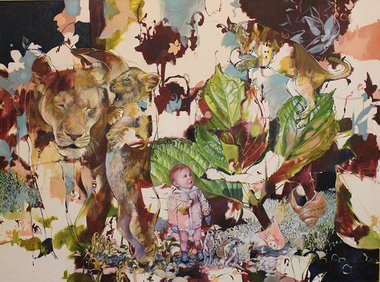
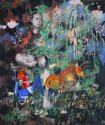
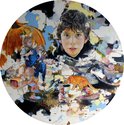
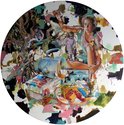

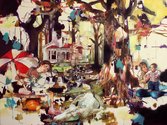
 Two Rooms presents a program of residencies and projects
Two Rooms presents a program of residencies and projects Advertising in this column
Advertising in this column



This Discussion has 3 comments.
Comment
Jim Middlebrook, 12:22 a.m. 6 July, 2013 #
The art critic is faced with making the tough calls. So thank you Peter [Dornauf] for a very thoughtful and well-written article on Jasmine's work (and to the EyeContactSite forum, which I apologize for not finding sooner, having been abroad). I have a personal understanding of my daughter's work, and may be asked by the industry to write on it later, but meanwhile I will comment briefly here. I concede that Peter makes some very astute observations, and several accurate interpretive statements, with (um) a few reservations. Later Jasmine will be a little happier acknowledging/committing horror to canvas. Today, as you note, it is a bloodless sanctuary. But I would present the works themselves as prima facie evidence of her unquestionable ability. There is a place for raw symbolism and layered symbolism: Jasmine prefers, for now, an experimental foundation for the type of realism that won't scare the guests. And rather than "bag of tricks", which denotes repetition and lack of emotional investment, perhaps "repertoire" would reflect her guileless OCD/ASD approach?
Otherwise Peter, you have been genuine and not ungenerous in your appraisals. I know "Jazamy" takes everything with a cube of salt, but cannot inwardly deny the veracity of your words.
Ralph Paine, 11:01 p.m. 7 July, 2013 #
Making tough calls? To the contrary, it seems to me that Mr Dornauf is resting real easy here, lazily oiling up his little judgement machine with ill-founded formulas like “art VERSUS illustration” (emphasis added) and “craft is but the first step in the business we call art” (WTF??##!!—exactly who is the “we” of this ridiculous formula?). None of this really works, everything squeaks and rattles and keeps falling apart, but the sad thing is that it’s the artist who cops the wreckage in her face.
To take only one aspect: we get no definition of illustration. It’s as if illustration simply possesses some x-factor, a secret quality, an ‘I-don’t-have-to-explain-because-everybody-should-know’ kinda vibe. Roy Lichtenstein’s habit of taking comics and then modulating them via his painting practice is given as an example of how to tell the difference between art and illustration. But given Lichtenstein’s high regard for the comics (illustrations) he was selecting and transforming, this example seems way outta place here: Mr Dornauf postulates illustration as a negative thing compared to art, a degraded thing.
In a more neutral light, perhaps then mechanical reproduction—combined with certain kinds of commercial relation—has something to do with the difference. This would be closer to a working definition, but doesn’t seem current given today’s (or even yesterday’s) ever expanding modes of art production. Though I guess it does go towards helping explain the marvellously complex and rich historical relation between art and illustration (however we may wish to define these terms). Suggested questions: why was Baudelaire so fascinated by Constantin Guy’s illustrations? Why did Francis Bacon say of his work that “inevitably illustration has to come into it”? And so on and so forth....
So rather than setting up or restoring false hierarchies, it’s always a question of how an artist (in this case, a painter) modulates and moves (on a plane of composition) between illustration, photography, drawing, figuration/figure, resemblance, analogy, code, chance, etc. etc. Of how, in other words, an artist shape shifts things in a convergence toward some unique “matter of fact” (Bacon). No doubt even in this regard Mr Dornauf would find these paintings lacking. But does any of this entitle him to cast Ms Middlebrook out of the ranks of the artists? No way.
Jim Middlebrook, 3:34 a.m. 4 September, 2013 #
Thank you Ralph Paine. Really I was being rhetorical by saying nothing about whether Peter can rightfully make the tough calls by establishing his assertions as only a true critic could. Michaelangelo...illustrator? Albrect Durer...illustrator? I think I obscured my analogy: Peter's thoughtful and well-written style of critique mirrors what he disdains: illustration: something which adds nothing but merely reframes an existing set of assumptions concerning the world. As you noted, it may be possible to denigrate most (if not all) art as "illustration" or sketching to the degree of one's lack of comprehension concerning the scope and depth of the work, by narrowing upon a tiny section of a work, and then neglecting to relate that section to the work as a whole, and the work to humanity. So you are right to highlight this issue. An art critic should provide the significance of an artwork in place/time, and only speak about what the peice illustrates in broad terms. Of course it is of no value to say that any painting is illustrative unless you are prepared to hazard a guess as to what those formative elements symbolize. Damn, Da Vinci was just so illustrative! Thank you again Ralph.
Participate
Register to Participate.
Sign in
Sign in to an existing account.